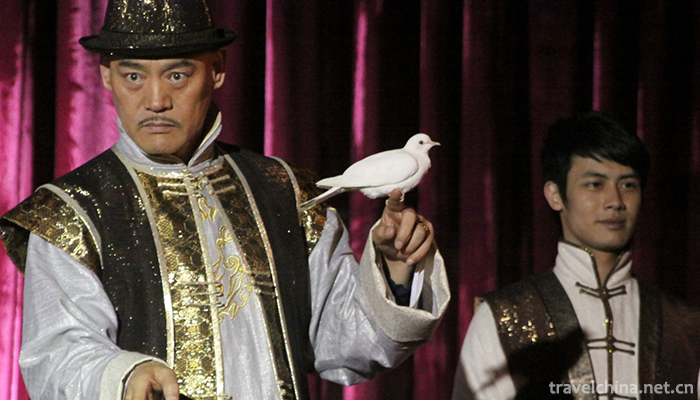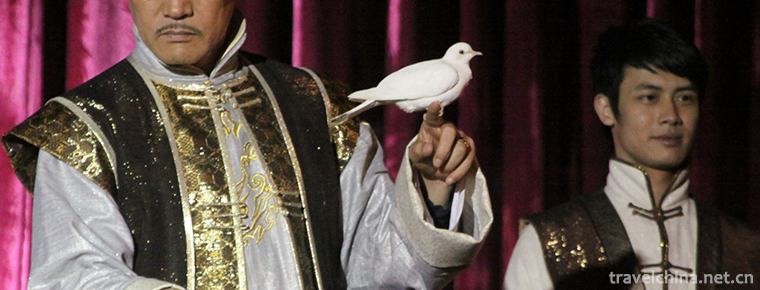conjuring tricks
conjuring;tricks
Conjuring tricks is one of the traditional Chinese acrobatics. Performers use agile methods to create audiovisual illusions, performing various objects, animals or water and fire and other rapid increase or decrease of hidden changes. China has a long history of juggling. According to Zhang Heng's "Xijing Fu" of the Han Dynasty, there were programs such as swallowing knives, spitting fire and painting ground into Sichuan as far back as the Han Dynasty.
Most of the props for tricks are daily necessities or production tools commonly used by the working people, such as pots, bowls, dishes, spoons, cages, boxes, cabinets, knives, etc.
On May 23, 2011, juggling was approved by the State Council to be included in the third batch of national intangible cultural heritage list.
Development
For thousands of years in ancient China, juggling has been a lasting folk art and a reflection of traditional Chinese culture.
Before the Qing Dynasty, artists performed in ancient costumes. In the Qing Dynasty, the performance of ancient costumes was banned by the Qing government. Since then, artists have been accustomed to wearing new long gowns and coats to perform. The costumes of jugglers follow this tradition, so artists who can see in modern times have been wearing coats to perform.
Prop
Most of the props of Chinese traditional tricks are daily necessities or production tools, such as pots, bowls, dishes, spoons, cages, boxes, cabinets, knives, etc.
technique
The trick is to "turn up and down, through diplomatic representation", which means that the gesture of handing over to the audience before the performance must be bright up, down, reverse and positive, and let the audience see Gabriel outside.
Colorful living
There are four sets of basic hand color work (i.e. hand skills) for "jugglers".
The trick is "Dan, sword, bean, ring". Dan is to swallow iron eggs, swords, swords, swords; beans, beans, beans picked by immortals (two bowls tied together seven gum beans, changing back and forth, no trace, no shadow in and out); rings, refers to nine continuous rings, the lead wire into nine iron rings, can be imagined as visible things, such as tricycles, official hats, flower baskets, lanterns and so on.
Distinguish
Modern so-called "magic" performance programs are mostly Western skills, belonging to foreign products, so the costumes of actors are suits or uniforms. Modern magic props originating in the West are unfamiliar to most audiences and are usually made of special features, such as magic sticks, magic guns, tin janes, magic vats, etc. The magic trick is "pull up with the upper finger and pull down with the left and right hand". When the actor lifts his finger upward and takes the opportunity to pull out the underlying things with the other hand, he calls it "pull down with the upper finger". When the actor shows the audience his left hand, he quickly pulls out the ambush with the right hand, which is called "pull up with the left and right hand".


-
2.The Ming Toms
The Obvious Tomb is located on Chunde Mountain, 5 kilometers northeast of Zhongxiang City, Hubei Province. It was built in 1519 in Zhengde, Ming Dynasty. It was built in 1566 in Jiajing
Time 2019-02-07 -
3.Fried egg with Longan
Oyster with longan is a dish name. Its raw materials have certain medicinal effects of traditional Chinese medicine and have medicinal effects on human body.
Time 2019-03-24 -
4.Dong Pipa Song
Dong Pipa song is distributed in the southern dialect area of Dong nationality, which can be divided into lyric and narrative Pipa song. Its singing content almost covers Dong history
Time 2019-04-28 -
5.Printing and Dyeing Techniques of Liquidambar formosana
Maple fragrance dyeing and production technology, Guizhou Huishui County, Majiang County, local traditional skills, one of the national intangible cultural heritage.
Time 2019-04-29 -
6.Mei Ge
Meige is the general name of Yi folk song and dance and folk oral literature. Its content is all-encompassing and almost reflects the history, culture, production and life of the Yi people. It is rega
Time 2019-06-02 -
7.Mongolian Sihu Music
Mongolian Sihu music is one of China's intangible cultural heritage. Mongolian Sihu is one of the most distinctive Mongolian musical instruments, stringed instruments.
Time 2019-06-04 -
8.Sanxianshu
Sanxianshu, also known as Qianzi Shu and Leg Blackboard Shu, is an ancient traditional rap art formed in Nanyang, Henan Province. It has a history of more than 250 years. It is named for its main acco
Time 2019-06-12 -
9.folk song of northern shaanxi
Northern Shaanxi folk song is a traditional folk song in northern Shaanxi, which can be divided into three categories: labor chant, Xintianyou and minor. Labor chants include tamping song, blockbuster
Time 2019-06-13 -
10.Yanbei Playing with Children
Yanbei children's play, also known as cough cavity, is popular in Datong City, Shanxi Province and its surrounding traditional drama, one of the national intangible cultural heritage.
Time 2019-07-10 -
11.Zong Baonao
The dance used for sacrifice - the Yao Zong Baonao Dance is evolved from an ancient legend. According to Changtang Yao people, from generation to generation, in ancient times, a beautiful Yao mother l
Time 2019-08-16 -
12.Dong Zhongshu
Dong Zhongshu (179 BC - 104 years ago), Guang Chuan (Hebei Jingxian County southwest, Jingxian County, Gucheng, Zaoqiang three counties junction) people, the Western Han Dynasty. philosopher emperor j
Time 2019-09-07